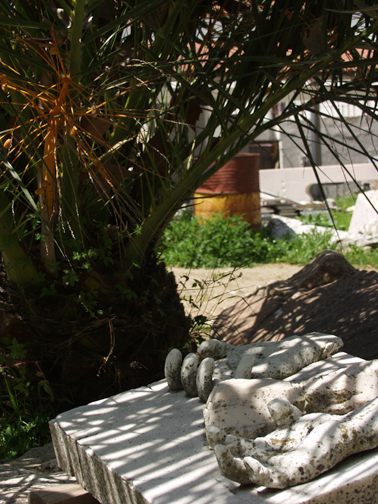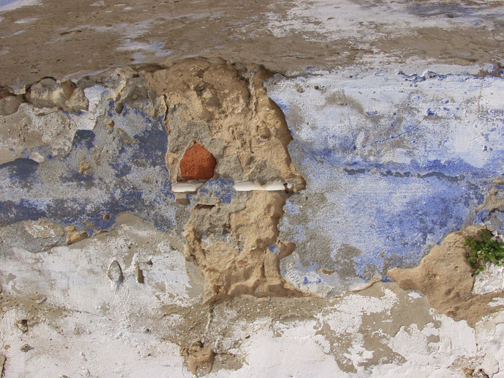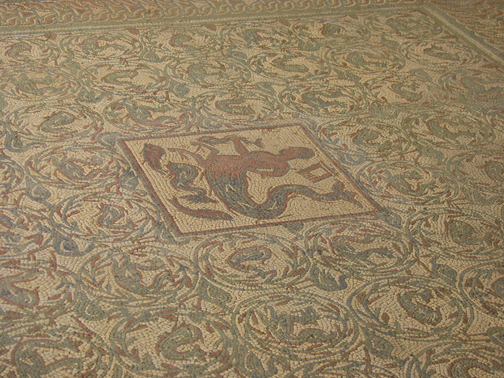Carmo: a theory of ruinas
Lisbon, Portugal, 2006
Trembling lightly, I put out my hand for the railing of the Santa Justa lift as it takes me and the others up and up, the patterned metal cage of the elevator flicking at my eyes, giving me jerky visions of pharmacies and photo shops, then an entire line of roofs, then another, as we rise up through two street levels.
Christy, I say out loud, I’m up above the rooftops now. I’m behind the angels. Way over across the downtown district are the enormous winged creatures that face the Praca de Comercio. They stand majestically, with their backs toward me, gesturing with arms that seem from this distance to be almost my size, if a mouse could look from a rooftop and decide that people in the street below were finally her size.
I am going to the Convent of the Carmelite Nuns, the Convento do Carmo, and the lift ascends to where a metal passageway connects the commercial district with the twisted winding streets of the Chiado district. This passageway extends from the tower, hovering three stories over the street below. Stepping out of the elevator I see that the passageway is gated and locked, and I can only stare across at the arches that touch the sky to such tender blues against the white stone, arches that come to faint points, just like my longing.
Without the passageway, the elevator is a dead end, with a cheap restaurant at the top. I will have to descend and go around the long way. Paulo will be sorry I came without him. He’ll say that now he won’t get a chance to draw in the ruins. But I’ll tell him I could go to the Carmo every day, because every time I see it I experience new forms of happiness, and curiosities, new confirmations that the universe is unfinished, a ruina, a place where pigeons dart through the gracious stone windows from the street and come out into the sky.
From the main platform I ascend a narrow spiral staircase of metal, which comes out one level above, where the workings of the elevator are housed: the counter weights.
I try my best not to look directly at the machinery as even a glance causes all of my bones to become fluid, quivering with vertigo. Up another level of staircase, and the dizziness increases, and I am at the restaurant on the roof of the world, serving hot dogs and coca cola, at eye level with the Carmo’s buttresses. I can look right across at the top floor of the restored Chiado buildings, destroyed in fire a few years ago.
It looks like the top floors have been converted into beautiful flats, unfortunately expensive, from what used to be decrepit rehearsal spaces for theater and dance. I take the elevator down again and map out the shortest route to Carmo: up the main street, closed to cars, that connects the commercial district with the Chiado, and the first right. As I trudge, I come to a square where I recognize the fountain and the massive wooden doors of the Carmo. A small brass plaque explains that the church and museum are closed, for “obras.”
Works. Repairs. Obras. Moments of heaven. Next door to the church, a police station. A uniformed officer with a rifle stands at attention in front. The square has two cafes and 490 pigeons. I sit on the steps of the fountain for a moment. Of course. It wouldn’t be possible, would it? Simply to walk in, to enter, to be devastated by the sky framed in walls that rise up three stories. It’s always the journey, never the end, never the magpie, always crust. My camera eases some of my disappointment and I am hungry. I am simple.
I take pen and knife off to the Brasileira Café, even though they don’t make their own pastries and what they have brought in isn’t fresh. But they serve outside on the cobbled square and from my metal table I have a full view of the bronze statue of the poet Fernando Pessoa. He is seated at a café table looking languid and thoughtful, and there is an empty bronzed chair beside him. Periodically people take each others’ pictures sitting next to him.
I sit and pay the only kind of homage I know how, with pen and journal, though it is weak, and I feel a distinct lack of poetry in my bones the last few days more often than any true spark of inspiration. Or, I feel so much that falls apart under the impact of words and I end up saying something else and that something else becomes important to others, and I am left feeling that I’ve spoken for no one, because I have not spoken for myself. However, I am angular and persistent and greedy, and I will make poetry simply by being in the world without credentials.
Once this is decided, of course, a young woman approaches the café with her mother, immaculately dressed, with a few daubs of simple, but bright makeup on. I notice her because she is wearing shoes similar to the ones I bought last week, black with square heels and square toes, and because her mouth is so pink and her cheeks rouged vibrantly. She carries a musical instrument case and I suspect she has just come from a recital and her mother is going to buy her a treat.
Her mother is also dressed very correctly in black, with new glossy jewelry and simple straightforward but forceful eye shadow and lipstick, a shade more sophisticated than her daughter. They begin to set their things down on a table. The girl abruptly puts down her coat, and walks across the square carrying her violin case. She sets it down at the feet of the statue of the poet Chiado and opens it, taking out a concert violin.
It is such a satisfying incongruity to see this creature that just walked off the hallowed floor of some private conservatory trilling out concertos to the public square. A man comes up to her, at first shyly, to listen, then becoming more aggressive, stumbling up until he is standing not more than a foot away from her. Is he drunk? A vagrant? Her mother intercedes, touching the man on the shoulder, trying to shame him into leaving. The girl plays on, smiling calmly. Over the course of the next ten minutes two different men come up and persuade the man to back off and let her play, but he only weaves away for a minute or so and returns.
No crowd needs to gather because a crowd is always gathered in the Largo de Chiado. Mom sits, elegant and stylish on a nearby chair, drinking beer out of a can. By now she has played half a dozen classical pieces, my little Carmo, my monument to the unfinished world, tearing and ripping sweet notes off of the violin and scattering them over the wandering groups of shoppers, business people, bohemians, gypsies, and students.
Other young people stop, carrying musical instrument cases themselves. They stand with soft, open eyes and slack lips, watching her movements, passing comments among themselves. People begin to clap now after each piece is finished, and to bring coins up and drop them into her case. The tramp hovers, reluctant and eager, perhaps called to dance in some dim corner of his alcoholic thought, perhaps even aware of the hostility which causes his eagerness to become a travesty of enjoyment, an assault on the white female in front of him playing music written in anglo countries, for anglo centuries.
Finally the curtain of onlookers shields me from her figure and I can only hear her strings, the hand that sails over the bow, giving it old notations in an afternoon of new and passing life.
How do we live, and where do we go when we die? Does our discernment give us any greater pleasure in the afterlife, or is it just one more thing to shed, one more arrogance on the descent to blandness.
Or is death bland—quiet wriggling of worms and flesh tattering. Is there nothing we can take or construct that would make its way over the chasm?
An old man stops to let me know that this girl playing music isn’t even Portuguese. She’s English. Why should so many people take an interest in her? She has sat down now. I see a red sore under her chin from holding the violin so violently against her life.
Forty million people in the world speak Portuguese, explains the man, more than Spanish. Spanish and Portuguese aren’t the same. Americans are stupid. They have no culture. They think Spanish and Portuguese are the same language.
One all sides, language stumbles against itself and breathes. Feet clack over the stones laid out in patterns that we saw at the Roman villa of Conimbriga near Coimbra. Mosaics of little stones. All the eyes of the crowd on this young woman who may be English, but she has bitten off her soul and chewed it in Portugal. So many jackets, so many legs. The statue there, says the old man, that’s Fernando Pessoa, a great writer. Portuguese. I nod. He continues. But he was a communist! So what, I say. That is a small thing. He is a writer, a fantastic writer.
And pink people go by and green people, and their shoes are made of mud and here comes a neurasthenic and there goes a worldly woman, and a gypsy with morning sickness.
Now that she has stopped playing, the young woman sits with her eyes unfocused, impatient with a long-haired artist who has invited himself to her table, seated himself at her altar, speaking eagerly to her. Who is it, I wonder, who sits beneath the statue of the poet Chiado without consequences? Which of us is carrying our stomach about the square after lunch, and which our shopping. Which of these people will remember this day as the moment we endeared ourselves to heaven? Beggars come by the table, some with real afflictions and some with feigned. I only listen to the old man. He’s just a crank, and an ornithologist. He flutters his words like the 900 pigeons that cover the statue of the Marquis de Pombal.
I pay my bill and stand.
Copyright ©2006 Theresa Whitehill, All Rights Reserved


